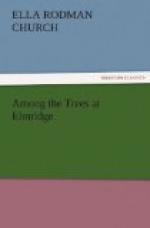CHAPTER VIII.
THE POPLARS.
The bruised foot was not comfortable to walk on for two or three days, and Edith was settled in the great easy arm-chair with dolls and toys and picture-books in a pile that seemed as if it would not stop growing until every article belonging to herself and Clara had been gathered there. “We can go on with our trees,” said Miss Harson, “even if we do not see them just yet; and this evening I should like to tell you something about the poplar, a large tree with alternate leaves which is often found in dusty towns, where it seems to flourish as well as in its favorite situation by a running stream. An old English writer calls the poplars ‘hospitable trees, for anything thrives under their shade.’ They are not handsomely-shaped trees, but the foliage is thick and pretty. In the latter part of this month—April—the trees are so covered with their olive-green catkins that large portions of the forests seem to be colored by them.”
[Illustration: IN THE EASY CHAIR]
“Are there any poplars at Elmridge?” asked Malcolm.
“Not nearer than the woods,” was the reply, “where we must go and look for them when Edith’s foot is quite well again, though there are a good many in the city. The poplar is often planted by the roadside because it grows so rapidly and makes a good shade. The Abele, or silver poplar, is an especial favorite for this purpose.
“The balm of Gilead, or Canada poplar, is the largest of the species, and really a handsome tree, often growing to the height of fifty or sixty feet, with a trunk of proportionate size. It has large leaves of a bright, glossy green, which grow loosely on long branches, A peculiarity of this tree is that before the leaves begin to expand the buds are covered with a yellow, glutinous balsam that diffuses a penetrating but very agreeable odor unlike any other. The balsam is gathered as a healing anodyne, and for many ailments it is a favorite remedy in domestic medicine. All the poplars produce more or less of this substance.
“The river poplaris found on the banks of rivers and brooks and in wet places, and is a noble and graceful tree. The trunk is light gray in color, and the young trees have a smooth, leather-like bark. The broad leaves, of a very rich green, grow on stems nearly as long as themselves, and the flowering aments are of a light-red color. The leaf-stalks and young branches are also brightly tinted. Another of these trees has a very singular name: it is called the necklace poplar.”
[Illustration: LOMBARDY POPLAR.]
“Do the flowers grow like real necklaces?” asked Clara.
“Not quite,” replied her governess, “but the reason given is something like it. The tree is so called from the resemblance of the long ament, before opening, to the beads of a necklace. In Europe it is known as the Swiss poplar and the black Italian poplar. Its timber is much valued there for building. There are also the black poplar and that queer, stiff-looking tree the Lombardy poplar. Cannot one of you tell me where there are some tall, narrow trees that look almost as if they had been cut out of wood and stuck there?”




